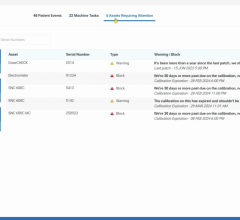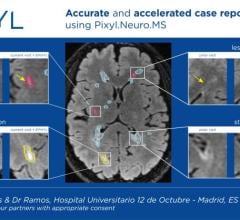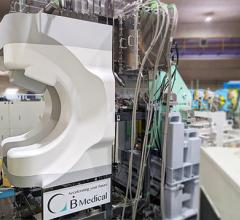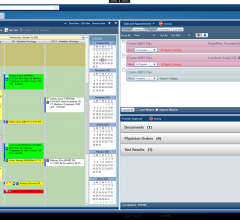
Jacob Phillip, director, Radiation Oncology, IMPAC Medical Systems, an Elekta company
One of the critical tools in the battle against cancer involves more than just a potent injectible serum, highly configured and targeted radiation beam or the skilled hands of an experienced surgeon.
It’s data. That’s why radiation oncologists invest in a comprehensive information system. An oncology information management system (OIMS) represents one of the key weapons in a radiation oncologist’s arsenal to wage war against deadly tumors and suspicious tissue growths in patients.
OIMS technology doesn’t just help them do their jobs better, which involves detecting, diagnosing and treating cancer, along with helping patients heal physically, mentally and emotionally. OIMS also are designed to help them do their jobs more efficiently by boosting productivity and improving workflow.
With such relatively recent advances as intensity modulated radiation therapy, image-guided radiation therapy and image-guided radiosurgery, as well as the latest advances approaching prime time, such as proton therapy and four-dimensional adaptive radiotherapy, radiation oncologists need OIMS technology that keeps pace, if not remains one step ahead, of the trends.
Consequently, Outpatient Care Technology strove to explore ongoing developments in OIMS applications and capabilities, including what enhancements may be in the conceptual phase and development now and how they will improve performance. So OPCT asked key executives at three of the leading OIMS manufacturers for their forecasts, based on what their healthcare customers are demanding.
Without giving away any company or trade secrets, conceptually how will the next-generation OIMS accommodate the larger volume data sets from the real-time images that comprise adaptive radiotherapy? Is the technology’s ability to handle multimodality capabilities for intensity modulated radiation therapy (IMRT), image-guided radiation therapy (IGRT) and image-guided radiosurgery (IGRS) just the tipping point?
Jacob Philip, director, Radiation Oncology, IMPAC Medical Systems, an Elekta company
One undeniable trend in the delivery of oncology treatment is the ever increasing volume and complexity of large data sets and images needed for adaptive radiotherapy. However, if this were the only dimension being considered, then the solution would be a simple matter of increasing raw storage capacity.
From IMPAC’s years of experience in studying and helping to refine oncology workflows, we understand that in order to be both efficient and effective, access to data and images should be completely and seamlessly integrated into the oncology workflow. For this reason, we have developed the first oncology-specific picture archiving and communication system, known as MOSAIQ Oncology PACS that is fully integrated into our MOSAIQ Oncology Information System. With this development, access and management of vital images and complex data sets from all different imaging and treatment modalities can be as adaptive and dynamic as the treatment itself. IMPAC’s vision for the future of oncology information and management systems is to continue to refine the technology and develop solutions that support open-systems connectivity and enhances the dynamic workflows of multi-modality adaptive treatment environments such as IGRT and IGRS.
Mark Wofford, vice president, Business Management, Siemens Healthcare, Image Knowledge Management Division
We already see the data volumes exploding in the diagnostic area from more advanced imaging systems (64-slice computed tomography, 4D ultrasound, mammography) and new hybrid imaging systems (PET-CT, SPECT-CT, PET-MR). These same challenges will certainly move toward the oncology area for both radiation therapy and the other oncology treatment modalities as imaging will become a major enabler before, during and after treatment. As a result, the next- generation OIMS will have to quickly follow the evolution of radiology information systems/PACS into high-volume, high-speed, high-availability and highly reliable image and data management systems, with multimodality, functional imaging applications that can exist anywhere in the enterprise. This will allow the raw data to be interpreted and utilized as knowledge by the appropriate caregiver in the appropriate point in the workflow.
Certainly it is only the tipping point. There will be an explosion of data generated before, intra-fraction, inter-fraction and after treatment in the form of multimodality, functional and even in-vitro data. The task for healthcare providers and their industry partners will be to convert this wave of raw data into knowledge that can be applied in a targeted manner somewhere in the care and treatment cycle. Because of the volume of data the real challenge for industry will be how to extract applicable knowledge that is timely and appropriate for the specific care giver.
Corey Zankowski, Ph.D., senior director, Software Systems Marketing, Varian Medical Systems
The future OIMS must enhance and simplify clinical workflows so that more procedures can be completed in less time, process large volumes of data to support complex clinical decision- making and track performance and outcomes data. To keep pace with image-guided adaptive radiotherapy, the next-generation OIMS will need to incorporate a full-featured oncology PACS solution. Adaptive radiotherapy is still in its infancy, yet clinicians already use volumetric images throughout the therapeutic process: PET and MR images for diagnosis, staging, tumor targeting and response assessment; CT for treatment planning; KV- or MV-CBCT for patient positioning and adaptive planning; and dose matrices for multiple image sets and adaptive plans.
Soon the majority of oncology treatment centers will access and generate peta-bytes of patient information annually. As image-guided oncology treatments become more common, practitioners face the challenge of managing and storing enormous amounts of clinical data. Clinics following extreme adaptive treatment processes may acquire 3D images and adapt treatment plans daily – as much as 40 times in a single course of treatment. Although this scenario seems unlikely today, at the rate technology is evolving, it is not hard to envision for sometime in the future. This would require massive, scalable data storage capacity. Moreover, adaptive therapy involves a highly collaborative work process that must be supported with sophisticated storage management and dataflow capabilities so that all members of the clinical team have rapid access to patient images when they are needed.




 July 11, 2024
July 11, 2024 








